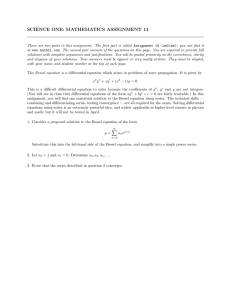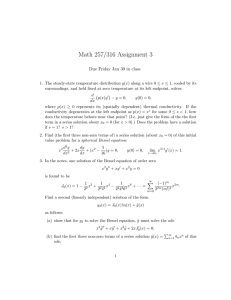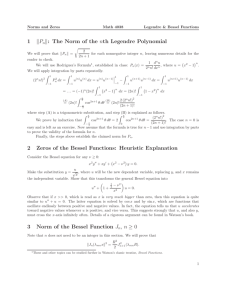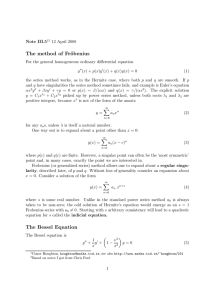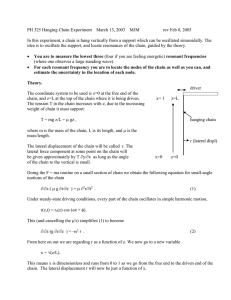Lecture 7 Regular Singular Points of Ordinary Differential Equations
advertisement
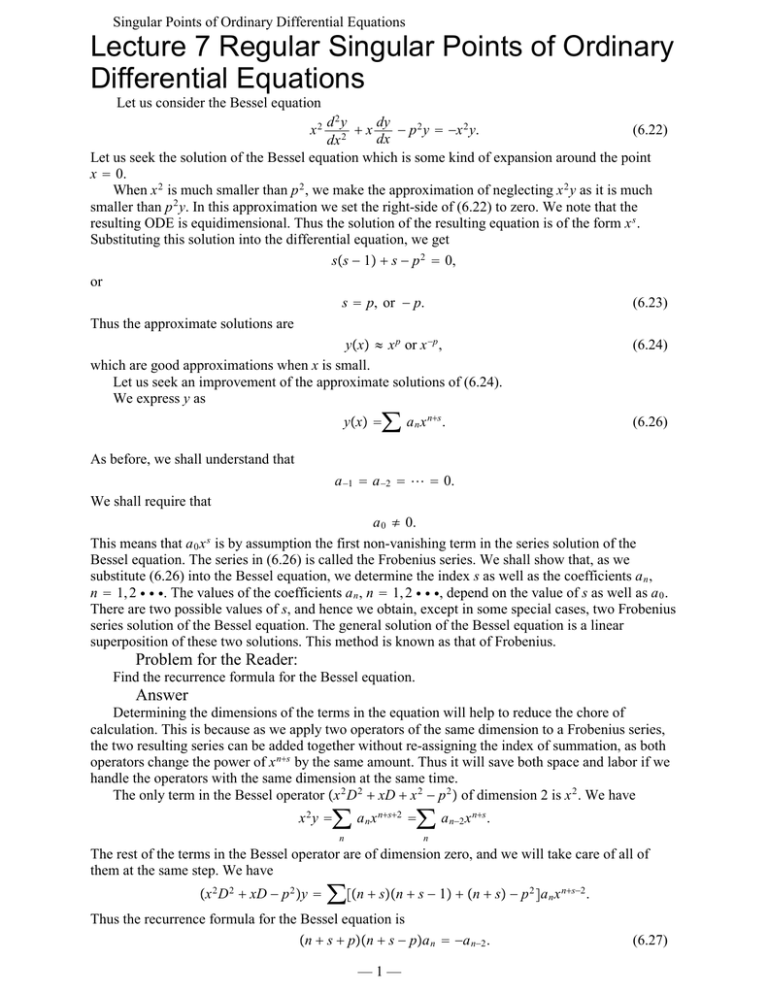
Singular Points of Ordinary Differential Equations Lecture 7 Regular Singular Points of Ordinary Differential Equations Let us consider the Bessel equation dy d2y +x ? p 2 y : ?x 2 y. (6.22) dx dx 2 Let us seek the solution of the Bessel equation which is some kind of expansion around the point x : 0. When x 2 is much smaller than p 2 , we make the approximation of neglecting x 2 y as it is much smaller than p 2 y. In this approximation we set the right-side of (6.22) to zero. We note that the resulting ODE is equidimensional. Thus the solution of the resulting equation is of the form x s . Substituting this solution into the differential equation, we get sΩs ? 1æ + s ? p 2 : 0, or s : p, or ? p. (6.23) Thus the approximate solutions are yΩxæ u x p or x ?p , (6.24) which are good approximations when x is small. Let us seek an improvement of the approximate solutions of (6.24). We express y as x2 yΩxæ :> a n x n+s . (6.26) As before, we shall understand that a ?1 : a ?2 : ` : 0. We shall require that a 0 é 0. This means that a 0 x is by assumption the first non-vanishing term in the series solution of the Bessel equation. The series in (6.26) is called the Frobenius series. We shall show that, as we substitute (6.26) into the Bessel equation, we determine the index s as well as the coefficients a n , n : 1, 2 6 6 6. The values of the coefficients a n , n : 1, 2 6 6 6, depend on the value of s as well as a 0 . There are two possible values of s, and hence we obtain, except in some special cases, two Frobenius series solution of the Bessel equation. The general solution of the Bessel equation is a linear superposition of these two solutions. This method is known as that of Frobenius. s Problem for the Reader: Find the recurrence formula for the Bessel equation. Answer Determining the dimensions of the terms in the equation will help to reduce the chore of calculation. This is because as we apply two operators of the same dimension to a Frobenius series, the two resulting series can be added together without re-assigning the index of summation, as both operators change the power of x n+s by the same amount. Thus it will save both space and labor if we handle the operators with the same dimension at the same time. The only term in the Bessel operator Ωx 2 D 2 + xD + x 2 ? p 2 æ of dimension 2 is x 2 . We have x 2 y :> a n x n+s+2 :> a n?2 x n+s . n n The rest of the terms in the Bessel operator are of dimension zero, and we will take care of all of them at the same step. We have Ωx 2 D 2 + xD ? p 2 æy : >øΩn + sæΩn + s ? 1æ + Ωn + sæ ? p 2 ¿a n x n+s?2 . Thus the recurrence formula for the Bessel equation is Ωn + s + pæΩn + s ? pæa n : ?a n?2 . —1— (6.27) Singular Points of Ordinary Differential Equations We note that there are only two coefficients in (6.27): a n and a n?2 . This is because there are only two different dimensions for the operators in the Bessel equation. To obtain the solution of the Bessel equation, we first set n : 0 in (6.27). Since a ?2 is zero and since a 0 é 0, we get Ωs + pæΩs ? pæ : 0. (6.28) Equation (6.28) is called the indicial equation. It determines the index s to be either s 1 or s 2 . We get s 1 : p, s 2 : ?p, in agreement with (6.23). Without loss of generality, we may assume that Re p ì 0, and hence Re s 1 ì Re s 2 . Next we write (6.27) as a n?2 , n ; 0. (6.29) an : ? Ωn + s + pæΩn + s ? pæ Problem for the Reader: Solve the recurrence formula (6.29). Answer Let us set n : 2m in (6.29). We get a 2Ωm?1æ . a 2m : ? s+p æ 4Ωm + 2 æΩm + s?p 2 By applying the above recurrence formula m times, we get with the help of (6.10) that a <Ω1 + s/2 + p/2æ<Ω1 + s/2 ? p/2æ . (6.30) a 2m : Ω?1æ m m 0 4 <Ωm + s/2 + p/2 + 1æ<Ωm + s/2 ? p/2 + 1æ The right-side of (6.30) depends on s, with the two values of s determined from the indicial equation (6.28) given by (6.23). Problem for the reader: Find a solution of the Bessel equation. Answer Setting s : p in (6.30), we get <Ω1 + pæa 0 . 4 m <Ωm + p + 1æ<Ωm + 1æ Thus one of the solutions of the Bessel equation is x 2m+p 2 J p Ωxæ :> Ω?1æ m , <Ωm + p + 1æ<Ωm + 1æ a 2m : Ω?1æ m (6.31) (6.32) n*0 where the immaterial constant multiple a 0 <Ω1 + pæ has been ignored. The function J p Ωxæ is known to be the Bessel function of order p. We may get a second solution of the Bessel equation by choosing s in (6.30) to be the other index ?p. But there is a slightly easier way. The Bessel equation is unchanged as we replace p by ?p. Thus another solution of the Bessel equation is obtained by replacing p in (6.32) by ?p. The solution obtained is J ?p Ωxæ. By (6.29), the ratio a n /a n?2 vanishes like 1/n 2 as n î K. Thus the series (6.32) converges for all values of x. Therefore, the series is not only useful as an approximate series when x is small. It is meaningful even if x is not small. However, when x is large, it is inefficient to calculate the values of the Bessel function J p Ωxæ with the series (6.32). Also, the series hardly tells us anything about the qualitative behavior of the Bessel function for large values of x. To get a hold on the behavior of the Bessel function for large values of x, it is a good idea to obtain its expansion in the variable x ?1 , rather than the variable x. Consider now the general second-order linear homogeneous differential equation y rr + cΩxæy r + dΩxæy : 0. (6.38) If cΩxæ and dΩxæ are both analytic at x 0 , x 0 is called an ordinary point of (6.38). And if either cΩxæ or dΩxæ or both have a singularity at x 0 , x 0 is called a singular point of (6.38). If x 0 is an ordinary point of (6.38), we may obtain the two independent solutions of (6.38) by seeking them in the form of a Taylor series expanded around x 0 : —2— Singular Points of Ordinary Differential Equations yΩxæ : > a n Ωx ? x 0 æ n , a ?1 : a ?2 : ` : 0. The coefficients a n , n : 2, 3 6 6 6, are determined from the recurrence formula obtained by plugging the series into the differential equation. These coefficients are dependent on a 0 and a 1 , which are arbitrary constants. We get two independent solutions, the first being obtained with the choice of a 0 : 1 and a 1 : 0, and the second one being obtained with the choice of a 0 : 0 and a 1 : 1. Let x 0 be a singular point of (6.38). There are two kinds of singular points. If x 0 is a singular point of (6.38) with Ωx ? x 0 æcΩxæ and Ωx ? x 0 æ 2 dΩxæ both analytic at x 0 , then x 0 is called a regular singular point of (6.38). The Bessel equation (6.22) takes the form p2 y rr + 1x y r + 1 ? 2 y : 0. x Comparing with (6.38), we find that the coefficient cΩxæ and dΩxæ for the Bessel equation are x ?1 and Ω1 ? p 2 /x 2 æ, respectively. The point x : 0 is a regular singular point of the Bessel equation, as cΩxæ has a simple pole and dΩxæ has a double pole at this point. Retuning to (6.38). We may obtain the solutions of (6.38) expanded around a regular singular point x 0 in the same way we obtained the solutions of the Bessel equation expanded around x : 0. More precisely, we seek these solutions in the form of the Frobenius series yΩxæ :> a n Ωx ? x 0 æ n+s , (6.39) n with a ?1 : a ?2 : ` : 0. The series is convergent at least up to the next singular point of (6.38). Finally, if either Ωx ? x 0 æcΩxæ or (x ? x 0 æ 2 dΩxæ or both are not analytic at x 0 , then x 0 is called an irregular singular point of (6.38). — 3 —
